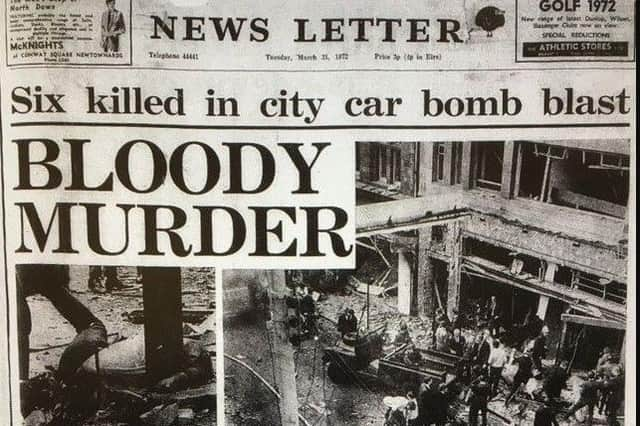Ben Lowry: It has been another week that highlighted the legacy scandal


I had a mind blank could not remember whether it was the Belfast Telegraph, where I worked in the early 2000s, or the News Letter, where I have worked for 15 years.
The answer was that both had been attacked by the IRA in the 1970s, when I was only a young child (hence my later uncertainty).
Advertisement
Hide AdAdvertisement
Hide AdThe News Letter bomb was placed outside the office on March 20 1972. No-one in the staff was killed, but seven people were on Donegall Street outside, a bustling civilian area.
The Belfast Telegraph was targeted in September 1976 when a bomb was driven to the building. Joseph Patton, from the stereotype department, was killed. The paper had in fact been targeted in early 1973, when a massive device was defused outside the entrance.
These events are so long forgotten that even I was unsure of them, despite having been following news from the 1980s, and despite having spent 22 years at those two titles.
They were not the only IRA attacks on the media. The Irish News was also a target, as was the BBC (the IRA set off a bomb at its Belfast headquarters in May 1972).
Advertisement
Hide AdAdvertisement
Hide AdA long-established journalist e-mailed me after our anniversary supplement last Monday, to mark 50 years since the Donegall Street massacre, to say that he thinks that the first such PIRA bomb at a newspaper was at a highly sophisticated new colour Daily Mirror printing plant in Suffolk on July 17 1971.
I cannot find a reference to this online, and have not yet been able to get clarity about this from my correspondent, but he seems to mean Suffolk in west Belfast, because he says printing reverted to Great Britain.
The point is that there were many IRA attacks on the media, and they have almost disappeared in the mists of time — even an attack as heinous as the News Letter bomb that killed seven people.
There is no campaign for justice for such dead. There is no hint of a legacy inquest into them or a major probe. Meanwhile this week fresh inquests were ordered into killings by loyalist or state forces.
There are already around 100 such inquests in the pipeline.
Advertisement
Hide AdAdvertisement
Hide AdAlso this week, the Public Prosecution was ordered to reconsider its decision to drop murder charges against a former soldier accused of killings on Bloody Sunday.
Many readers will have noticed that late last year and early this year, the News Letter serialised various excerpts from a book in defence of unionism, The Idea of the Union, Great Britain and Northern Ireland - Realities and Challenges.
The editors were John Wilson Foster and William Beattie Smith.
I was one of a number of people asked to contribute a chapter, and I did not hesitate. Indeed I made a personal donation to help get the book to press (in coming weeks I will write more about the book).
Advertisement
Hide AdAdvertisement
Hide AdThere are now few people defending unionism, such is the stigma that has become attached to such a position .For several years it has been not unusual to hear broadcast discussions in which nationalist views are stridently defended alongside ‘unionist’ voices who seem not to defend unionism.
This is particularly notable in discussions around legacy in which for years there were debates in which everyone involved supported the 2014 Stormont House Agreement on how to tackle the past. These typically ended in all contributors to the broadcast rounding on the UK government for not moving fast enough to implement that deal.
It was the News Letter 2018 Stop the Legacy Scandal series of essays that unveiled the depth of concern there was at how the past was being handled in order to justify terrorism and demonise British state forces, and how the mooted Stormont House deal might just continue that trend. Yet for years after that series I have heard broadcasts in which all contributors support Stormont House.
On Thursday we ran an article by Jeff Dudgeon, who has been one of the most long-standing and articulate critics of the pro terrorist direction of legacy.
Advertisement
Hide AdAdvertisement
Hide AdMy chapter in the aforementioned book was on the legacy scandal. The events of this week, the anniversary of yet another massacre by the IRA, and yet the advance of yet more probes into a state that prevented civil war, has merely reaffirmed my view that there is an enduring moral collapse around legacy.